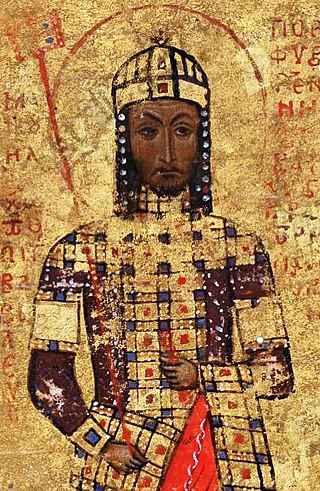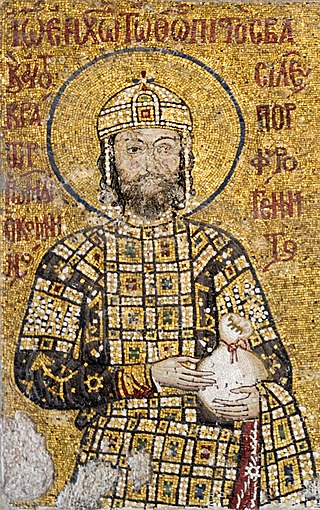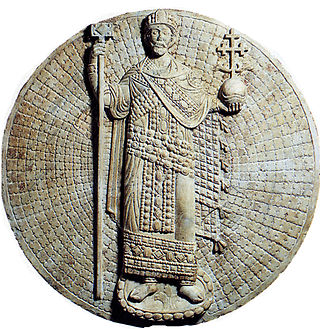
Manuel I Komnenos, also called Porphyrogenitus, was a Byzantine emperor of the 12th century who reigned over a crucial turning point in the history of Byzantium and the Mediterranean. His reign saw the last flowering of the Komnenian restoration, during which the Byzantine Empire had seen a resurgence of its military and economic power and had enjoyed a cultural revival.

John II Komnenos was Byzantine emperor from 1118 to 1143. Also known as "John the Beautiful" or "John the Good", he was the eldest son of Emperor Alexios I Komnenos and Irene Doukaina and the second emperor to rule during the Komnenian restoration of the Byzantine Empire. As he was born to a reigning emperor, he had the status of a porphyrogennetos. John was a pious and dedicated monarch who was determined to undo the damage his empire had suffered following the Battle of Manzikert, half a century earlier.

The Battle of Myriokephalon was a battle between the Byzantine Empire and the Seljuk Turks in the mountains west of Iconium (Konya) in southwestern Turkey on 17 September 1176. The battle was a strategic reverse for the Byzantine forces, who were ambushed when moving through a mountain pass.

Béla III was King of Hungary and Croatia between 1172 and 1196. He was the second son of King Géza II and Géza's wife, Euphrosyne of Kiev. Around 1161, Géza granted Béla a duchy, which included Croatia, central Dalmatia and possibly Sirmium. In accordance with a peace treaty between his elder brother, Stephen III, who succeeded their father in 1162, and the Byzantine Emperor Manuel I Komnenos, Béla moved to Constantinople in 1163. He was renamed to Alexios, and the emperor granted him the newly created senior court title of despotes. He was betrothed to the Emperor's daughter, Maria. Béla's patrimony caused armed conflicts between the Byzantine Empire and the Kingdom of Hungary between 1164 and 1167, because Stephen III attempted to hinder the Byzantines from taking control of Croatia, Dalmatia and Sirmium. Béla-Alexios, who was designated as Emperor Manuel's heir in 1165, took part in three Byzantine campaigns against Hungary. His betrothal to the emperor's daughter was dissolved after her brother, Alexios, was born in 1169. The emperor deprived Béla of his high title, granting him the inferior rank of kaisar.

Stephen IV was King of Hungary and Croatia, ascending to the throne between 1163 and 1165, when he usurped the crown of his nephew, Stephen III. He was the third son of Béla II of Hungary, and when his conspiracy against his brother Géza II failed, he was exiled from Hungary in the summer of 1157. He first sought refuge in the Holy Roman Empire, but received no support from Emperor Frederick I. Shortly afterwards he moved to the Byzantine Empire, where he married a niece of Emperor Manuel I Komnenos, Maria Komnene, and converted to the Eastern Orthodox Church.

Ladislaus II or Ladislas II was King of Hungary and Croatia between 1162 and 1163, having usurped the crown from his nephew, Stephen III.

Stephen III was King of Hungary and Croatia between 1162 and 1172. He was crowned king in early June 1162, shortly after the death of his father, Géza II. However, his two uncles, Ladislaus and Stephen, who had joined the court of the Byzantine Empire, challenged his right to the crown. Only six weeks after his coronation, the Byzantine Emperor Manuel I Komnenos launched an expedition against Hungary, forcing the Hungarian lords to accept Ladislaus' rule. Stephen sought refuge in Austria, but returned and seized Pressburg. Ladislaus, who died on 14 January 1163, was succeeded by Stephen's younger uncle and namesake, Stephen IV, without resistance, but his rule was unpopular. The young Stephen defeated his uncle on 19 June 1163 and expelled him from Hungary.

The Byzantine army of the Komnenian era or Komnenian army was a force established by Byzantine emperor Alexios I Komnenos during the late 11th/early 12th century. It was further developed during the 12th century by his successors John II Komnenos and Manuel I Komnenos. From necessity, following extensive territorial loss and a near disastrous defeat by the Normans of southern Italy at Dyrrachion in 1081, Alexios constructed a new army from the ground up. This new army was significantly different from previous forms of the Byzantine army, especially in the methods used for the recruitment and maintenance of soldiers. The army was characterised by an increased reliance on the military capabilities of the immediate imperial household, the relatives of the ruling dynasty and the provincial Byzantine aristocracy. Another distinctive element of the new army was an expansion of the employment of foreign mercenary troops and their organisation into more permanent units. However, continuity in equipment, unit organisation, tactics and strategy from earlier times is evident. The Komnenian army was instrumental in creating the territorial integrity and stability that allowed the Komnenian restoration of the Byzantine Empire. It was deployed in the Balkans, Italy, Hungary, Russia, Anatolia, Syria, the Holy Land and Egypt.

The Byzantine Empire was ruled by emperors of the Komnenos dynasty for a period of 104 years, from 1081 to about 1185. The Komnenian period comprises the reigns of five emperors, Alexios I, John II, Manuel I, Alexios II and Andronikos I. It was a period of sustained, though ultimately incomplete, restoration of the military, territorial, economic and political position of the Byzantine Empire.
The Battle of Hyelion and Leimocheir saw the almost complete destruction by the Byzantines of a large Seljuq Turk army. The Seljuq army had been raiding Byzantine territory in the Maeander Valley in Anatolia, and had sacked a number of cities. The Byzantine force ambushed the Turks at a river crossing.
Boris, also known as Boris Kalamanos was a claimant to the Hungarian throne in the middle of the 12th century. He was the son of Euphemia of Kiev, the second wife of Coloman the Learned, King of Hungary. After Euphemia was caught in adultery, Coloman expelled her from Hungary and never acknowledged that he was Boris's father. However, Boris, who was born in the Kievan Rus', regarded himself as the king's lawful son. He laid claim to Hungary after Coloman's firstborn and successor, Stephen II of Hungary, died in 1131. Boris made several attempts to assert his claims against kings Béla II and Géza II with the assistance of Poland, the Holy Roman Empire and the Byzantine Empire, but failed and was killed in a battle.
Andronikos Komnenos Kontostephanos, Latinized Andronicus Contostephanus, was a major figure in the Byzantine Empire during the reign of his uncle Manuel I Komnenos as a general, admiral, politician and a leading aristocrat.

The Battle of Haram or Chramon was fought between the forces of King Stephen II of Hungary and Emperor John II Komnenos of the Byzantine Empire in the year 1128, or possibly earlier – in 1125, in what is now Serbia, and resulted in a major defeat for the Hungarians.
John Komnenos Vatatzes, or simply John Komnenos or John Vatatzes in the sources, was a major military and political figure in the Byzantine Empire during the reigns of Manuel I Komnenos and Alexios II Komnenos. He was born c. 1132, and died of natural causes during a rebellion he raised against Andronikos I Komnenos in 1182.
Andronikos Lapardas or Andronicus Lapardas was a Byzantine general during the late Komnenian period.
The Battle of Constantinople in 1147 was a large-scale clash between the forces of the Byzantine Empire and the German crusaders of the Second Crusade, led by Conrad III of Germany, fought on the outskirts of the Byzantine capital, Constantinople. The Byzantine emperor Manuel I Komnenos was deeply concerned by the presence of a large and unruly army in the immediate vicinity of his capital and of the unfriendly attitude of its leaders. A similarly sized French crusader army was also approaching Constantinople, and the possibility of the two armies combining at the city was viewed with great alarm by Manuel. Following earlier armed clashes with the crusaders, and perceived insults from Conrad, Manuel arrayed some of his forces outside the walls of Constantinople. Part of the German army then attacked and was defeated; according to British historian Michael Angold, they suffered heavy losses. Following this defeat the crusaders agreed to be quickly ferried across the Bosporus to Asia Minor.
Denis was an influential lord in the Kingdom of Hungary in the second half of the 12th century. He was Palatine of Hungary in 1184, Ban of Slavonia between 1181 and 1184, Ban of Dalmatia in 1183, and ispán of at least three counties. He was a commander of the Hungarian army fighting against the Byzantine Empire in the reign of Stephen III of Hungary.
Andronikos Angelos Doukas was a Byzantine aristocrat related to the ruling Komnenos dynasty. During the reign of his cousin, Manuel I Komnenos, he served without success as a military commander against the Seljuk Turks, and as envoy to the Kingdom of Jerusalem. Following Manuel's death, in 1182 he was sent to stop the rebellion of Andronikos I Komnenos, but was defeated and eventually defected to him. Shortly after, he led a failed conspiracy of leading aristocrats against Andronikos I. When it was discovered, Andronikos and his sons fled the Empire, ending up in Acre, where he died. He was the father of emperors Isaac II Angelos and Alexios III Angelos.
A Byzantine–Hungarian War was fought between Byzantine and Hungarian forces on the Danube between 1127 and 1129. Byzantine primary sources, Cinnamus and Choniates, give little detail about this campaign; no dates are specified, and what they do say differs considerably.
The Byzantine–Hungarian War was a series of border conflicts between the Byzantine Empire and the Kingdom of Hungary that took place in the Balkans from 1149 to 1155. The conflict was affected by international disputes in Europe, primarily between Manuel I Komnenos and Roger II of Sicily, starting in the 1140s. The war broke out when Géza II of Hungary provided military assistance to the Serbs of Rascia (Raška), who rebelled against Byzantine suzerainty. The conflict ended with a peace treaty that restored the status quo ante bellum and established peace for five years. In 1161, the parties agreed to extend the truce for ten years but the relationship between them remained hostile, causing further clashes throughout the 12th century.










